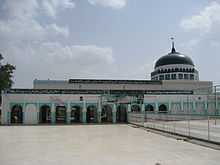Chishtian
| Chishtian چشتیاں Chishtian Shareef | |
|---|---|
| City | |
| Chishtian | |
 | |
| Nickname(s): چشتیاں | |
 Chishtian | |
| Coordinates: 29°48′N 72°50′E / 29.800°N 72.833°ECoordinates: 29°48′N 72°50′E / 29.800°N 72.833°E | |
| Country |
|
| Province | Punjab |
| District | Bahawalnagar District |
| Tehsil | Tehsil Chishtian |
| Elevation | 511 ft (155 m) |
| Population (1998) | |
| • Total | 101,659 |
| Time zone | PST (UTC+5) |
| • Summer (DST) | +6 (UTC) |
| Area code(s) | 62350(ZIP),063(Landline) |
Chishtian (Punjabi,Urdu: چشتیاں) is located in Tehsil Chishtian of district Bahawalnagar of province of the Punjab of Pakistan. The city of Hazrat Khawaja Noor Muhammad Maharvi RA. The city is situated at 150 meters above sea level. It was a sub-division of Bahawalpur Division, which was part of Bahawalpur State. Chishtian Mandi name is common among old aged persons due to the grain market, the economical hub of the city. The city is also called as Chishtian Shareef, name due to the presence of shrines of Sufi saints.There are several mills and factories located in Chishtian.
History
In 997 CE, Sultan Mahmud Ghaznavi, took over the Ghaznavid dynasty empire established by his father, Sultan Sebuktegin, In 1005 he conquered the Shahis in Kabul in 1005, and followed it by the conquests of Punjab region. The Delhi Sultanate and later Mughal Empire ruled the region. The Punjab region became predominantly Muslim due to missionary Sufi saints whose dargahs dot the landscape of Punjab region.
Chishtian city was founded by Sufi saint Shaikh Khawaja Tajuddin Chishti around 1265 CE (574 Hijri, Islamic calendar). The town is called Chishtian because of the of Sufi Chishti Order. He was grandson of Sufi saint Fariduddin Ganjshakar of Pakpattan.
The predominantly Muslim population supported Muslim League and Pakistan Movement. After the independence of Pakistan in 1947 many Muslim refugees from India settled in Chishtian.
Pilgrimage site
Shaikh Khawaja Tajuddin Chishti made this place his abode about seven centuries ago and spread Islam to the local population of area. Later on, he embraced martyrdom and was buried there. He was one of the earliest Muslim saints in the South Asia. Later, about 250 years ago, the great saint of Chishtia silsla (one of the spiritual chains of Sufism). Khawaja Noor Muhammad Maharvi was born in the neighbouring village, Mahar Sharif and was a famous Sufi.[1]
Both saints' tombs are in the old city. Poorani (Old) Chishtian is so called because in the first quarter of the 20th century a new planned Chishtian was built just two kilometers southeast of Poorani Chishtian. Many followers come every year to visit their tombs and create a spiritual scene.
Economy
The Grain Market of Chishtian is a business hub of the area. Chishtian is surrounded by small industries and huge agricultural farms. A sugar mill also operates in vicinity of the city. The city is also popular because of its cotton crop. A paper mill, many cotton factories and ice factories and a few flour mills are working in Tehsil Chishtian.
Chishtian is connected with the world by metalled roads, railroads, telephone (PTCL Code: 063), mobile services available in Pakistan, and Pakistan Post (Postal Code: 62350).
Education
Colleges are Science College, Sir Syed College and Punjab College for intermediate level education while Government Post Graduate College–Chishtian and the Government Post Graduate College For Girls–Chishtian are for higher studies.
Gallery
-
Chishtian city was founded by Sufi saint Taj Sarwar Chishti in year 574 Hijri (Islamic Calendar), around the year 1265
-

Shrine of Khawaja Noor Muhammad Maharvi is also located in the old Chishtian.